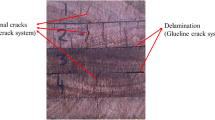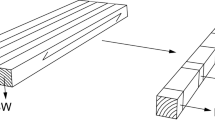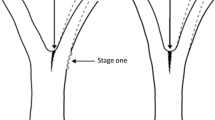Abstract
This study investigated the influence of growth rings (earlywood, earlywood and latewood interface, and latewood) on the mode I fracture toughness of solid wood of the two species southern yellow pine (Pinus taeda L.) and red oak (Quercus falcata) subjected to cracking loads in their radial-longitudinal crack propagation system. Experimental results indicated that southern yellow pine latewood had a significantly greater fracture toughness than its earlywood as well as its earlywood and latewood interface. The earlywood and latewood interface of southern yellow pine had a greater fracture toughness than its earlywood, but this difference was not significant. Red oak latewood had a greater fracture toughness than its earlywood and latewood interface, however this difference was not significant. Red oak earlywood had a significantly lower fracture toughness than its latewood and earlywood and latewood interface. In general, red oak had a significantly greater fracture toughness than southern yellow pine. The differences in specific gravity among latewood, earlywood and latewood interface, and earlywood for each of the two wood species evaluated were significant. The mode I fracture toughness of a tested wood block in its radial-longitudinal crack propagation system can be affected by not only its specific gravity but also by its microstructure such as ray cell size and quantity. The regression analyses indicated a strong positive linear relationship existed between the fracture toughness and specific gravity for the two wood species evaluated. The rate of increase in fracture toughness of red oak was about three times of southern yellow pine as their specific gravity increased.









Similar content being viewed by others
References
Ando K, Ohta M (1999) Variability of fracture toughness by the crack tip position in an annual ring of coniferous wood. J Wood Sci 45:275–283
Ashby MF, Easterling KE, Harrysson R, Maiti SK (1985) The fracture and toughness of woods. Proc R Soc Lond Math Phys Eng Sci 398(1815):261–280. https://doi.org/10.1098/rspa.1985.0034
ASTM (2009) E 399–09: Standard test method for linear-elastic plane-strain fracture toughness KIC of metallic materials. American Society for Testing and Materials, West Conshohocken
ASTM (2014) D 2395: Standard test method for density and specific gravity (relative density) of wood and wood-based materials. American Society for Testing and Materials, West Conshohocken
Atack D, May WD, Morris EL, Sproule RN (1961) The energy of tensile and cleavage fracture of black spruce. Tappi 44(8):555–567
Boatright SWJ (1977) Studies on the fracture and fatigue of wood. Master’s Thesis, University of Cape Town, South Africa
Broek D (1988) The practical use of fracture mechanics. Kluwer Academic Publishers, Dordrecht
Conrad MPC, Smith GD, Fernlund G (2003) Fracture of solid wood: a review of structure and properties at different length scales. Wood Fiber Sci 35(4):570–584
Fonselius M, Riipola K (1992) Determination of fracture toughness for wood. J Struct Eng 118(7):1727–1740. https://doi.org/10.1061/(ASCE)0733-9445(1992)118:7(1727)
Freund RJ, Wilson WJ (1997) Statistical methods. Academic Press, San Diego
Gibson LJ, Ashby MF (1997) Cellular solids: structure and properties. Cambridge University Press, Cambridge
Glass SV, Zelinka SL (2010) Moisture relations and physical properties of wood. In: Ross RJ (ed) Wood handbook: wood as an engineered material. Forest Products Society, Madison, pp 4.1-4.19
Johnson JA (1973) Crack initiation in wood plates. Wood Sci 6(2):151–158
Kang CW, Schwarzkopf M, Muszynski L, Jin T, Park HJ, Kang HY, Matsumura J (2014) Mechanical behavior of separated earlywood and latewood of douglas-fir using digital image correlation method. J Fac Agric Kyushu Univ 59(1):127–131
Kretschmann DE (2008) The influence of juvenile wood content on shear parallel, compression, and tension perpendicular to grain strength and mode I fracture toughness of loblolly pine at various ring orientation. For Prod J 58(7–8):89–96
Kretschmann DE (2010) Mechanical properties of wood. In: Ross RJ (ed) Wood handbook: wood as an engineered material. Forest Products Society, Madison, pp 5.1-5.46
Kretschmann DE, Green DW (1996) Modeling moisture content-mechanical property relationships for clear southern pine. Wood Fiber Sci 28(3):320–337
Kretschmann DE, Cramer SM (2007) The role of earlywood and latewood properties on dimensional stability of loblolly pine. In: Proceedings of the Compromised Wood Workshop, 29 January 2007, Christchurch, New Zealand, pp 215–236
Kretschmann DE, Green DW, Malinauskas V (1991) Effect of moisture content on stress intensity factors in Southern pine. In: Proceedings of the 1991 international timber engineering conference, vol 3. 2–5 September 1991, London, pp 3.391–3.398
Mall S, Murphy JF, Shottafer JE (1983) Criterion for mixed mode fracture in wood. J Eng Mech 109(3):680–690. https://doi.org/10.1061/(ASCE)0733-9399(1983)109:3(680)
Nakao T, Susanti CME, Yoshihara H (2012) Examination of the failure behavior of wood with a short crack in the radial–longitudinal system by single-edge-notched bending test. J Wood Sci 58(5):453–458. https://doi.org/10.1007/s10086-012-1266-6
Ohuchi T, Hermawan A, Fujimoto N (2011) Basic studies on fracture toughness of sugi and acoustic emission. J Fac Agric Kyushu Univ 56(1):99–102
Patton-Mallory M, Cramer SM (1987) Fracture mechanics: a tool for predicting wood component strength. For Prod J 37(7/8):39–47
Petterson RW, Bodig J (1983) Prediction of fracture toughness of conifers. Wood Fiber Sci 15(4):302–316
Porter AW (1964) On the mechanics of fracture in wood. For Prod J 14(8):325–331
Qiu LP, Zhu EC, Zhou HZ, Liu LY (2012) Fracture toughness of northeast china larch. Key Eng Mater 517:661–668. https://doi.org/10.4028/www.scientific.net/KEM.517.661
Reiterer A, Tschegg S (2002) The influence of moisture content on the mode I fracture behaviour of sprucewood. J Mater Sci 37(20):4487–4491
Reiterer A, Sinn G, Stanzl-Tschegg SE (2002) Fracture characteristics of different wood species under mode I loading perpendicular to the grain. Mater Sci Eng, A 332(1–2):29–36. https://doi.org/10.1016/S0921-5093(01)01721-X
Schachner H, Reiterer A, Stanzl-Tschegg SE (2000) Orthotropic fracture toughness of wood. J Mater Sci Lett 19(20):1783–1785
Schniewind AP, Centeno JC (1973) Fracture toughness and duration of load factor I. Six principal systems of crack propagation and the duration factor for cracks propagating parallel to grain. Wood Fiber Sci 5(2):152–159
Schniewind AP, Ohgama T, Aoki T, Yamada T (1982) Effect of specific gravity, moisture content and temperature on fracture toughness of wood. Wood Science 15(2):101–109
Shmulsky R, Jones PD (2011) Forest products and wood science: an introduction. Wiley
Smith I, Landis E, Gong M (2003) Fracture and fatigue in wood. Wiley
Thuvander F, Berglund LA (2000) In situ observations of fracture mechanisms for radial cracks in wood. J Mater Sci 35(24):6277–6283
Tukiainen P, Hughes M (2016) The cellular level mode I fracture behaviour of spruce and birch in the RT crack propagation system. Holzforschung 70(2):157–165. https://doi.org/10.1515/hf-2014-0297
Valentin G, Adjanohoun G (1992) Applicability of classical isotropic fracture mechanics specimens to wood crack propagation studies. Mater Struct 25(1):3–13
Vasic S, Stanzl-Tschegg S (2007) Experimental and numerical investigation of wood fracture mechanisms at different humidity levels. Holzforschung 61(4):367–374. https://doi.org/10.1515/HF.2007.056
Watanabe K, Shida S, Ohta M (2011) Evaluation of end-check propagation based on mode I fracture toughness of sugi (Cryptomeria japonica). J Wood Sci 57(5):371–376. https://doi.org/10.1007/s10086-011-1187-9
Wessel ET (1968) State of the art of the WOL specimen for fracture toughness testing. Eng Fract Mech 1(1):77–103
Wiedenhoeft A (2010) Structure and function of wood. In: Ross RJ (ed) Wood handbook: wood as an engineered material. Forest Products Society, Madison, pp 3.1-3.18
Wilson E, Mohammadi MS, Nairn JA (2013) Crack propagation fracture toughness of several wood species. Adv Civil Eng Mater 2(1):316–327. https://doi.org/10.1520/ACEM20120045
Wu Y, Shao Z, Wang F (2012) Study on wood fracture parallel to the grains based on fractal geometry. Int J Fract 176(2):163–169. https://doi.org/10.1007/s10704-012-9732-0
Yoshihara H (2010a) Examination of the mode I critical stress intensity factor of wood obtained by single-edge-notched bending test. Holzforschung 64(4):501–509. https://doi.org/10.1515/hf.2010.083
Yoshihara H (2010b) Influence of loading conditions on the measurement of mode I critical stress intensity factor for wood and medium-density fiberboard by the single-edge-notched tension test. Holzforschung 64(6):735–745. https://doi.org/10.1515/hf.2010.119
Yoshihara H, Usuki A (2011) Mode I critical stress intensity factor of wood and medium-density fiberboard measured by compact tension test. Holzforschung 65(5):729–735. https://doi.org/10.1515/hf.2011.063
Acknowledgements
This project was partially funded by the Turkish Ministry of National Education.
Author information
Authors and Affiliations
Corresponding author
Ethics declarations
Conflict of interest
On behalf of all authors, the corresponding author states that there is no conflict of interest.
Additional information
Publisher's Note
Springer Nature remains neutral with regard to jurisdictional claims in published maps and institutional affiliation'.
Rights and permissions
About this article
Cite this article
Konukcu, A.C., Quin, F. & Zhang, J. Effect of growth rings on fracture toughness of wood. Eur. J. Wood Prod. 79, 1495–1506 (2021). https://doi.org/10.1007/s00107-021-01738-7
Received:
Accepted:
Published:
Issue Date:
DOI: https://doi.org/10.1007/s00107-021-01738-7




